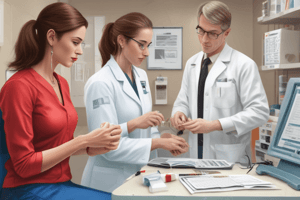Podcast
Questions and Answers
What is the primary purpose of phlebotomy?
What is the primary purpose of phlebotomy?
- To administer medication to patients
- To monitor patient vital signs
- To collect blood samples for laboratory testing (correct)
- To perform blood transfusions
Which of the following veins is typically selected for phlebotomy?
Which of the following veins is typically selected for phlebotomy?
- Median cubital vein
- Cephalic vein
- Ulnar vein
- Vein in the antecubital fossa (correct)
What is the purpose of the tourniquet in phlebotomy?
What is the purpose of the tourniquet in phlebotomy?
- To constrict blood flow and facilitate venipuncture (correct)
- To clean the skin with an antiseptic
- To stop bleeding at the puncture site
- To insert the needle into the vein
Which type of phlebotomy is commonly used for blood gas analysis?
Which type of phlebotomy is commonly used for blood gas analysis?
What is a critical aspect of phlebotomy that ensures patient safety and prevents complications?
What is a critical aspect of phlebotomy that ensures patient safety and prevents complications?
What is the primary purpose of using a tourniquet in phlebotomy?
What is the primary purpose of using a tourniquet in phlebotomy?
What is the main reason phlebotomists must wear personal protective equipment (PPE)?
What is the main reason phlebotomists must wear personal protective equipment (PPE)?
What is the purpose of using vacuum tubes in phlebotomy?
What is the purpose of using vacuum tubes in phlebotomy?
What is an essential step in phlebotomy to prevent accidental needlesticks?
What is an essential step in phlebotomy to prevent accidental needlesticks?
What is the purpose of gauze pads in phlebotomy?
What is the purpose of gauze pads in phlebotomy?
Flashcards are hidden until you start studying
Study Notes
Definition and Purpose
- Phlebotomy is the practice of drawing blood from a patient for diagnostic or therapeutic purposes.
- The purpose of phlebotomy is to collect blood samples for laboratory testing, which helps in diagnosing and monitoring diseases.
Phlebotomy Procedure
- The procedure involves selecting a suitable vein, typically in the antecubital fossa (bend of the elbow) or dorsal surface of the hand.
- The phlebotomist cleans the skin with an antiseptic, ties a tourniquet above the chosen vein, and inserts a needle into the vein.
- The blood is collected into a vacuum tube or syringe, and the tourniquet is removed.
- The needle is withdrawn, and the puncture site is pressed with a gauze pad to stop bleeding.
Types of Phlebotomy
- Venipuncture: The most common type, involving the collection of blood from a vein using a needle and syringe.
- Capillary puncture: Involves collecting blood from a capillary, usually from the finger or heel of a newborn.
- Arterial puncture: Rarely performed, involves collecting blood from an artery, usually for blood gas analysis.
Importance of Phlebotomy
- Accurate diagnosis and treatment of diseases rely on high-quality blood samples.
- Phlebotomy plays a critical role in patient care, as it helps in monitoring disease progression and response to treatment.
- Proper phlebotomy technique is essential to ensure patient safety and prevent complications.
Phlebotomy Equipment
- Needles: Sterile, disposable needles are used to collect blood samples.
- Syringes: Used to collect blood samples, available in various sizes.
- Vacuum tubes: Pre-evacuated tubes containing anticoagulants or additives to preserve blood samples.
- Tourniquet: Used to restrict blood flow and facilitate vein access.
- Gauze pads: Used to apply pressure to the puncture site and stop bleeding.
Phlebotomy Safety Precautions
- Universal precautions: Phlebotomists must wear personal protective equipment (PPE) to prevent exposure to bloodborne pathogens.
- Proper hand hygiene: Phlebotomists must wash their hands before and after the procedure.
- Proper disposal of sharps: Needles and other sharps must be disposed of in designated containers to prevent accidental needlesticks.
- Patient identification: Phlebotomists must verify patient identity to ensure accurate labeling of blood samples.
Studying That Suits You
Use AI to generate personalized quizzes and flashcards to suit your learning preferences.




